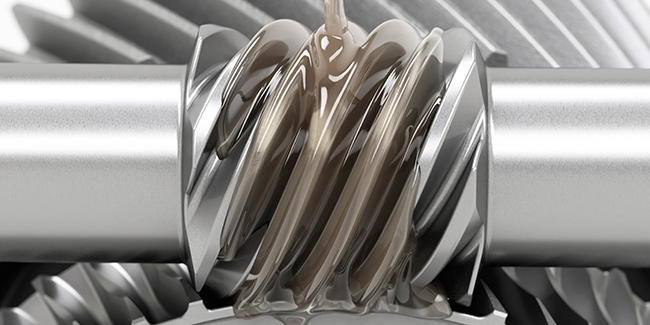5 Things You Should Consider When Selecting a Worm Gear Lubricant
Choosing the right lubricant for your component is almost as important as picking the component itself. Lubricants play a critical role in improving the performance of our components, but not all lubricants are suitable for every application. A lubricant that cannot withstand the operating conditions of your application, such as temperature or speed, will not adequately protect your component from wear and corrosion and can even accelerate the process. Worm gear lubrication presents unique challenges to design engineers who must consider the high sliding nature of the gear assembly.

Worm gears come in a variety of sizes from power steering units to small DC motors and typically transmit higher torque ratios. Therefore, typical worm and wheel materials can vary anywhere from stainless steel, to nylon, to even some yellow metals (brass, bronze, etc.). Not all greases formulated for worm gears are created equal. Here are five things you should consider when selecting a worm gear lubricant:
Viscosity
Worm gears undergo more sliding motion than rolling motion. Rolling motions will migrate lubricant around the entire gear box to ensure that all components, including the contact zone, are sufficiently lubricated. Repetitive sliding motions will push the lubricant away from the contact zone. Lubricants with a high base oil viscosity are recommended to ensure that the lubricant can migrate effectively to all areas of the gear box under sliding conditions. PAO based lubricants offer wider temperature performance and better viscosity index than mineral oil base products. While choosing the correct base oil viscosity is paramount, temperature and loading conditions should also be considered when selecting the proper lubricant.
Temperature
The predominantly sliding contact of the worm gear generates significant friction and high operating temperatures in the assembly. This is a problem for designers who wish to maximize gearbox efficiency without giving off too much heat. When a lubricant cannot withstand high temperatures, it will oxidize and leave behind several by products such as acids. These acids attack the metal surface and lead to increased wear and corrosion of the gear. Lubricants for worm gears should be able to withstand operating temperatures of up to 125°C.
Additives
Due to the sliding contact of worm gears resulting in high friction and operating temperatures, worm gears operate predominantly under boundary lubrication conditions making extreme pressure (EP) additives a logical choice. Many engineers will not select a grease with an extreme pressure additive because they often contain active sulfur which can soften, etch, or corrode yellow metals. Many EP additives at Nye use inactive sulfur that prevents the corrosive attack of the gear surface. Inactive sulfur forms a soft slippery chemical layer on the metal surface which protects against severe wear and welding. Lubricants with EP additives have greater film strength to reduce friction and protect your gear from wear.
Material Compatibility
Many applications, such as Electric Power Steering systems, use a combination of plastic and metal components within their gear assembly. It is important to select a lubricant that is compatible with all the materials in your assembly. Incompatible lubricants can penetrate plastics and cause several adverse physical and chemical reactions that affect its mechanical properties.
First, plastic can absorb oil and swell. Second, oil can extract solubles from plastic and shrink it. Finally, chemical interactions can affect the molecular structure of the plastic where a slight chemical change may lead to loss in mechanical performance such as embrittlement.
The lower the viscosity of the oil, the greater the possibility that it can penetrate plastics. Esters should be approached with caution as they have been known to attack certain plastics and elastomers. With so many different variations of plastics and elastomers, compatibility testing is always recommended to ensure that it will work properly in your specific application.
Noise
Noise-free operation is becoming increasingly important to consumers. Lubricants reduce frictional vibration to minimize noise emissions.
Below is a partial list of the most commonly used Nye synthetic lubricants for worm gear applications:
| Product | Base Oil Chemistry | Temperature Range (°C) | Base Oil Viscosity @ 40°C |
|---|---|---|---|
| RHEOLUBE 363F | PAO | -50 to 125 | 51.7 cSt |
| RHEOLUBE 380-G1 | PAO/Ester | -50 to 130 | 37 cSt |
| RHEOLUBE 362HB | PAO | -40 to 125 | 32.6 cSt |
| RHEOLUBE 462CF | PAO | -54 to 130 | 27.1 cSt |


